Toyota Yaris 2007 User Manual

FOREWORD
This repair manual has been prepared to provide essential information on body panel repair methods (including cutting and welding operations, but excluding painting) for the TOYOTA YARIS.
Applicable models: KSP90 series
NCP90, 91 series
This manual consists of body repair methods, exploded diagrams and illustrations of the body components and other information relating to body panel replacement such as handling precautions, etc. However, it should be noted that the front fenders of, this TOYOTA model are bolted on and require no welding.
When repairing, don't cut and join areas that are not shown in this manual. Only work on the specified contents to maintain body strength.
Body construction will sometimes differ depending on specifications and country of destination. Therefore, please keep in mind that the information contained herein is based on vehicles for general destinations.
For the repair procedures and specifications other than collisiondamaged body components of the TOYOTA YARIS refer to the repair manuals.
If you require the above manuals, please contact your TOYOTA dealer.
All information contained in this manual is the most up-to-date at the time of publication. However, specifications and procedures are subject to change without prior notice.
VIEWS OF THIS TEXT
Scope of the repair work explanation
This text explains the welding panel replacement instructions from the vehicle's white body condition. We have abbreviated the explanations of the removal and reinstallation of the equipment parts up to the white body condition and of the installation, inspection, adjustment and final inspection of equipment parts after replacing the weld panel.
Section categories
This manual has been divided as shown below.
Section Title |
Contents |
Examples |
|
|
|
|
|
INTRODUCTION |
Explanation of general body repair. |
Cautionary items. |
|
Views of weld panel replacement instructions. |
Views of weld panel replacement instructions. |
||
|
|||
|
|
|
|
|
Instructions for replacing the weld panels |
Front side member replacement. |
|
BODY PANEL REPLACEMENT |
from the white body condition, from which |
Quarter panel replacement. |
|
bolted parts have been removed, with |
|
||
|
|
||
|
individual supply parts. |
|
|
|
|
|
|
BODY DIMENSIONS |
Body aligning measurements. |
Dimension diagrams. |
|
|
|
|
|
PAINT COATING |
Scope and type of anti-rust treatment, etc. |
Under coating. |
|
together with weld panel replacement. |
Body sealer. |
||
|
|||
|
|
|
Contents omitted in this manual.
Make sure to perform the following essential procedures, although they are omitted in this manual.
(1)Jack and lift operations.
(2)Clean and wash removed parts, if necessary.
(3)Visual inspection.
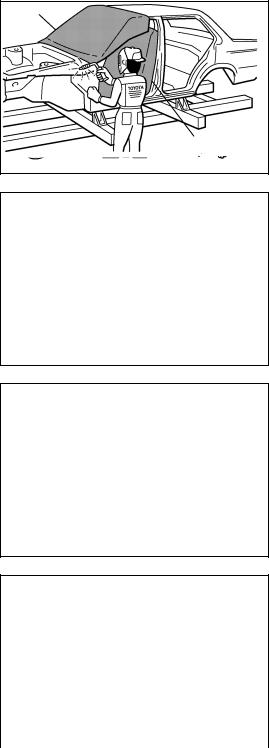
INTRODUCTION |
IN-1 |
Glass Cover
Seat Cover
F10001A
GENERAL REPAIR INSTRUCTIONS
1.WORK PRECAUTIONS
(a)VEHICLE PROTECTION
(1)When welding, protect the painted surfaces, windows, seats and carpet with heat resistant, fireproof covers.
(b)SAFETY
(1)Never stand in a direct line with the chain when using a puller on the body or frame, and be sure to attach a safety cable.
WRONG
F10002A
(2)Before performing repair work, check for fuel leaks. If a leak is found, be sure to close the opening completely.
(3)If it is necessary to use a flame in the area of the fuel tank, first remove the tank and plug the fuel line.
WRONG |
F10003A |
(c)SAFETY WORK CLOTHES
(1)In addition to the usual mechanic's wear, cap and safety shoes, the appropriate gloves, head protector, glasses, ear plugs, face protector, dust-prevention mask, etc. should be worn as the situation demands.
|
|
Code |
Name |
|
|
|
|
|
|
A |
Dust-Prevention Mask |
|
|
|
|
|
|
B |
Face Protector |
|
|
|
|
F10004A |
|
C |
Eye Protector |
|
|
|
|
|
|
D |
Safety Shoes |
|
|
|
|
|
|
E |
Welder's Glasses |
|
|
|
|
|
|
F |
Ear Plugs |
|
|
|
|
|
|
G |
Head Protector |
|
|
|
|
|
|
H |
Welder's Gloves |
|
|
|
|
IN-2 |
INTRODUCTION |
2.HANDLING PRECAUTIONS OF PLASTIC BODY PARTS
(1)The repair procedure for plastic body parts must conform with the type of plastic material.
(2)Plastic body parts are identified by the codes in the following table.
(3)When repairing metal body parts adjoining plastic body parts (by brazing, frame cutting, welding, painting etc.), consideration must be given to the properties of the plastic.
|
|
Heat* |
|
|
|
Code |
Material |
resistant |
Resistance to |
Notes |
|
name |
temperature |
alcohol or gasoline |
|||
|
|
||||
|
|
limit C ( F) |
|
|
|
|
|
|
|
|
|
|
Acrylonitrile |
80 |
Alcohol is harmless if applied only for |
Avoid gasoline and organic |
|
AAS |
short time in small amounts (e.g., quick |
||||
Acrylic Styrene |
(176) |
or aromatic solvents. |
|||
|
wiping to remove grease). |
||||
|
|
|
|
||
|
|
|
|
|
|
|
Acrylonitrile |
80 |
Alcohol is harmless if applied only for |
Avoid gasoline and organic |
|
ABS |
short time in small amounts (e.g., quick |
||||
Butadiene Styrene |
(176) |
or aromatic solvents. |
|||
|
wiping to remove grease). |
||||
|
|
|
|
||
|
|
|
|
|
|
|
Acrylonitrile |
80 |
Alcohol is harmless if applied only for |
Avoid gasoline and organic |
|
AES |
short time in small amounts (e.g., quick |
||||
Ethylene Styrene |
(176) |
or aromatic solvents. |
|||
|
wiping to remove grease). |
||||
|
|
|
|
||
|
|
|
|
|
|
|
Acrylonitrile |
80 |
Alcohol is harmless if applied only for |
Avoid gasoline and organic |
|
ASA |
Styrene |
short time in small amounts (e.g., quick |
|||
(176) |
or aromatic solvents. |
||||
|
Acrylate |
wiping to remove grease). |
|||
|
|
|
|||
|
|
|
|
|
|
|
Cellulose |
80 |
Alcohol is harmless if applied only for |
Avoid gasoline and organic |
|
CAB |
short time in small amounts (e.g., quick |
||||
Acetate |
(176) |
or aromatic solvents. |
|||
|
wiping to remove grease). |
||||
|
|
|
|
||
|
|
|
|
|
|
|
Ethylene |
100 |
Alcohol is harmless. |
Most solvents are harmless |
|
EPDM |
Gasoline is harmless if applied only for |
but avoid dipping in gasoline, |
|||
Propylene |
(212) |
||||
|
short time in small amounts. |
solvents, etc. |
|||
|
|
|
|||
|
|
|
|
|
|
|
Fiber |
180 |
|
|
|
FRP |
Reinforced |
Alcohol and gasoline are harmless. |
Avoid alkali. |
||
(356) |
|||||
|
Plastics |
|
|
||
|
|
|
|
||
|
|
|
|
|
|
|
Ethylene |
70 |
Alcohol is harmless if applied only for |
Avoid gasoline and organic |
|
EVA |
short time in small amounts (e.g., quick |
||||
Acetate |
(158) |
or aromatic solvents. |
|||
|
wiping to remove grease). |
||||
|
|
|
|
||
|
|
|
|
|
|
|
Ethylene/ |
|
|
|
|
|
Vinyl |
70 |
Alcohol is harmless if applied only for |
Avoid gasoline and organic |
|
E/VAC |
Acetate |
short time in small amounts (e.g., quick |
|||
(158) |
or aromatic solvents. |
||||
|
Copolymer |
wiping to remove grease). |
|||
|
|
|
|||
|
Resin |
|
|
|
|
|
|
|
|
|
|
PA |
Polyamide |
80 |
Alcohol and gasoline are harmless. |
Avoid battery acid. |
|
(Nylon) |
(176) |
||||
|
|
|
|||
|
|
|
|
|
|
PBT |
Polybutylene |
160 |
Alcohol and gasoline are harmless. |
Most solvents are harmless. |
|
Terephthalate |
(320) |
||||
|
|
|
|||
|
|
|
|
|
|
|
|
120 |
|
Avoid gasoline, brake fluid, |
|
PC |
Polycarbonate |
Alcohol is harmless. |
wax, wax removers and |
||
(248) |
|||||
|
|
|
organic solvents. Avoid alkali. |
||
|
|
|
|
||
|
|
|
|
|
*Temperatures higher than those listed here may result in material deformation during repair.
|
|
|
INTRODUCTION |
IN-3 |
|
|
|
|
|
|
|
|
|
Heat* |
|
|
|
Code |
Material |
resistant |
Resistance to |
Notes |
|
name |
temperature |
alcohol or gasoline |
|||
|
|
||||
|
|
limit C ( F) |
|
|
|
|
|
|
|
|
|
PE |
Polyethylene |
80 |
Alcohol and gasoline are harmless. |
Most solvents are harmless. |
|
(176) |
|||||
|
|
|
|
||
|
|
|
|
|
|
PET |
Polyethylene |
75 |
Alcohol and gasoline are harmless. |
Avoid dipping in water. |
|
Terephthalate |
(167) |
||||
|
|
|
|||
|
|
|
|
|
|
|
Polymethyl |
80 |
Alcohol is harmless if applied only for |
Avoid dipping or immersing |
|
PMMA |
in alcohol, gasoline, |
||||
Methacrylate |
(176) |
short time in small amounts. |
|||
|
solvents, etc. |
||||
|
|
|
|
||
|
|
|
|
|
|
POM |
Polyoxymethylene |
100 |
Alcohol and gasoline are harmless. |
Most solvents are harmless. |
|
(Polyacetal) |
(212) |
||||
|
|
|
|||
|
|
|
|
|
|
PP |
Polypropylene |
80 |
Alcohol and gasoline are harmless. |
Most solvents are harmless. |
|
(176) |
|||||
|
|
|
|
||
|
|
|
|
|
|
|
Composite |
80 |
|
|
|
PPF |
Reinforced |
Alcohol and gasoline are harmless. |
Most solvents are harmless. |
||
(176) |
|||||
|
Polypropylene |
|
|
||
|
|
|
|
||
|
|
|
|
|
|
|
Modified |
100 |
|
Gasoline is harmless if |
|
PPO |
Polyphenylene |
Alcohol is harmless. |
applied only for quick wiping |
||
(212) |
|||||
|
Oxide |
|
to remove grease. |
||
|
|
|
|||
|
|
|
|
|
|
|
|
60 |
Alcohol and gasoline are harmless if |
Avoid dipping or immersing |
|
PS |
Polystyrene |
applied only for short time in small |
in alcohol, gasoline, |
||
(140) |
|||||
|
|
amounts. |
solvents, etc. |
||
|
|
|
|||
|
|
|
|
|
|
|
|
80 |
Alcohol is harmless if applied only for very |
Avoid dipping or immersing |
|
PUR |
Polyurethane |
short time in small amounts (e.g., quick |
in alcohol, gasoline, |
||
(176) |
|||||
|
|
wiping to remove grease). |
solvents, etc. |
||
|
|
|
|||
|
|
|
|
|
|
|
|
|
Alcohol and gasoline are harmless if |
Avoid dipping or immersing |
|
|
Polyvinylchloride |
80 |
applied only for short time in small |
||
PVC |
in alcohol, gasoline, |
||||
(Vinyl) |
(176) |
amounts (e.g., quick wiping to remove |
|||
|
solvents, etc. |
||||
|
|
|
grease). |
||
|
|
|
|
||
|
|
|
|
|
|
|
Styrene |
80 |
Alcohol is harmless if applied only for |
Avoid dipping or immersing |
|
SAN |
short time in small amounts (e.g., quick |
in alcohol, gasoline, |
|||
Acrylonitrile |
(176) |
||||
|
wiping to remove grease). |
solvents, etc. |
|||
|
|
|
|||
|
|
|
|
|
|
|
Thermoplastic |
80 |
Alcohol is harmless. |
Most solvents are harmless |
|
TPO |
Gasoline is harmless if applied only for |
but avoid dipping in gasoline, |
|||
Olefine |
(176) |
||||
|
short time in small amounts. |
solvents, etc. |
|||
|
|
|
|||
|
|
|
|
|
|
|
Thermoplastic |
80 |
Alcohol is harmless if applied only for |
Avoid dipping or immersing |
|
TPU |
short time in small amounts (e.g., quick |
in alcohol, gasoline, |
|||
Polyurethane |
(176) |
||||
|
wiping to remove grease). |
solvents, etc. |
|||
|
|
|
|||
|
|
|
|
|
|
|
TOYOTA |
80 |
|
|
|
TSOP |
Super |
Alcohol and gasoline are harmless. |
Most solvents are harmless. |
||
(176) |
|||||
|
Olefine Polymer |
|
|
||
|
|
|
|
||
|
|
|
|
|
|
UP |
Unsaturated |
110 |
Alcohol and gasoline are harmless. |
Avoid alkali. |
|
Polyester |
(233) |
||||
|
|
|
|||
|
|
|
|
|
*Temperatures higher than those listed here may result in material deformation during repair.
IN-4 |
INTRODUCTION |
3.LOCATION OF PLASTIC BODY PARTS
Parts Name |
Code |
|
|
Front Bumper Cover |
TSOP |
|
|
Radiator Grille |
TSOP |
|
|
Headlight |
PC/PP |
|
|
Fog Light |
TSOP |
|
|
Front Pillar Upper Cover |
AES |
|
|
Side Turn Signal Light |
PMMA/PC/ABS |
|
|
Cowl Top Ventilator Louver |
TSOP/PP/PE |
|
|
Rear Body Mudguard |
PP |
|
|
Door Outside Handle |
PA/PC/PBT |
|
|
Outer Rear View Mirror |
PP/PA/ABS ASA |
|
|
Front Door Window Frame Front Moulding |
ASA |
|
|
Front Spoiler Cover |
TSOP |
|
|
Front Fender Mudguard |
PP |
|
|
Back Door Outside Handle |
PA |
|
|
License Plate Light |
PC |
|
|
Rear Combination Light |
PMMA/ASA |
|
|
Rear Bumper Cover |
TSOP |
|
|
|
HINT: |
|
Resin material differs depending on mod- |
|
el. |
|
/ Made up of 2 or more kinds of materials. |
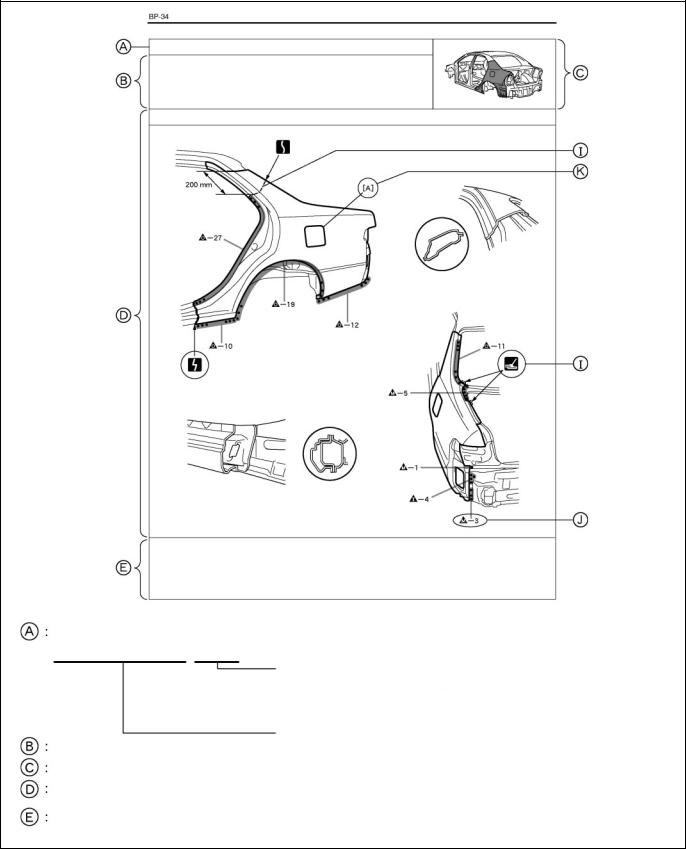
INTRODUCTION |
IN-5 |
HOW TO USE THIS MANUAL
1.BODY PANEL REPLACEMENT IN THIS MANUAL
BODY PANEL REPLACEMENT
QUARTER PANEL (CUT)
REPLACEMENT
REMOVAL
POINT
1. Remove the [A] at the same time.
PART NAME
[A] Fuel filler opening lid 200 mm (7.87 in.)
REPLACEMENT PART AND METHOD
QUARTER PANEL (CUT)
Replacement method
(ASSY)...Assembly replacement
(CUT)...Major cutting (less than 1/2 of part used) (CUT-H)...Half cutting (about 1/2 of part used) (CUT-P)...Partial cutting (most of part used)
Replacement part
REMOVAL CONDITIONS
PART LOCATION
REMOVAL DIAGRAM
Describes in detail the removal of the damaged part involving repair by cutting.
REMOVAL GUIDE
Provides additional information to more efficiently help you perform the removal.
F13890A
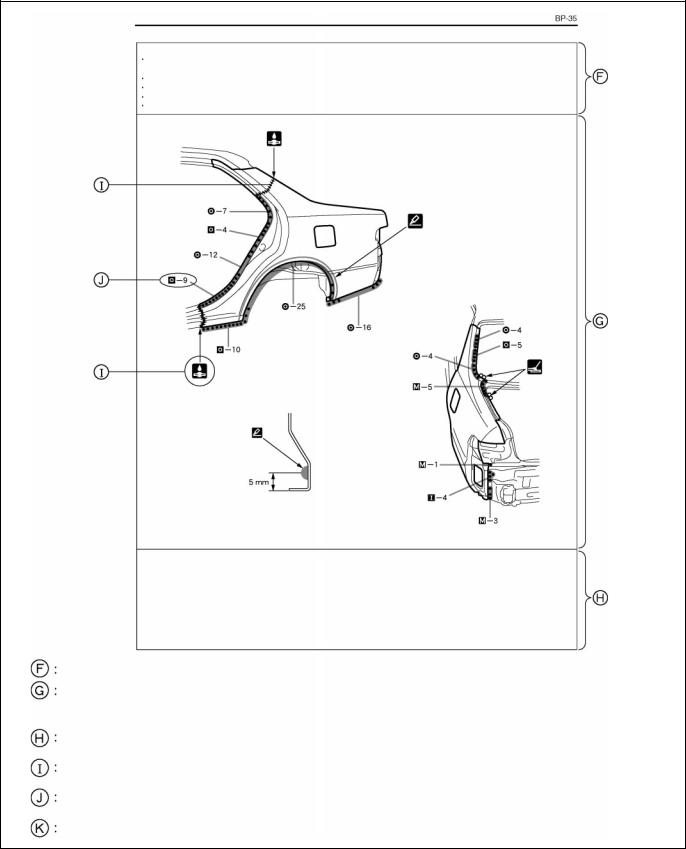
IN-6 |
INTRODUCTION |
BODY PANEL REPLACEMENT
INSTALLATION
Temporarily install the new parts and measure each part of the new parts in accordance with the body dimension diagram. (See the body dimension diagram)
Inspect the fitting of the related parts around the new parts before welding. This affects the appearance of the finish.
After welding, apply the polyurethane foam to the corresponding parts.
After welding, apply body sealer and under-coating to the corresponding parts.
After applying the top coat layer, apply anti-rust agent to the inside of the necked section structural weld spots.
POINT
1. Before temporarily installing the new parts, apply sealer to the wheel arch.
HINT
1)Apply body sealer about 5 mm (0.20 in.) front the flange, avoiding any oozing.
2)Apply sealer evenly, about 3−4 mm (0.12−0.16 in.) in diameter
3)For other sealing points, refer to section PC.
INSTALLATION CONDITIONS
INSTALLATION DIAGRAM
Describes in detail the installation of the new parts involving repair by welding and/or cutting, but excluding painting.
INSTALLATION GUIDE
Provides additional information to more efficiently help you perform the installation.
SYMBOLS
(See page IN-7)
INSTALLATION OF WELD POINTS
Weld method and panel position symbols (See page IN-9)
PART NAME
F13891A
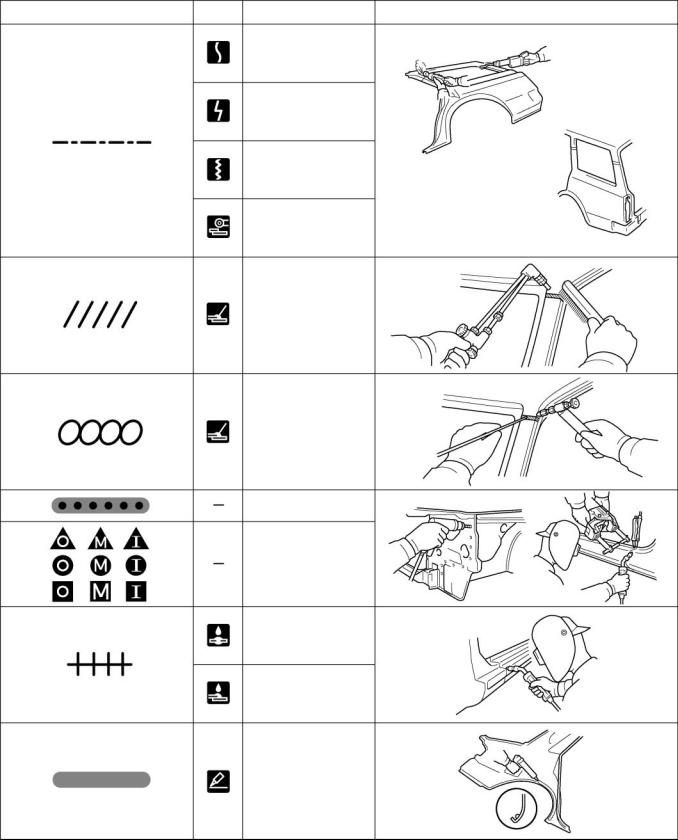
INTRODUCTION |
IN-7 |
2.SYMBOLS
The following symbols are used in the welding diagrams in section BP of this manual to indicate cutting areas and the types of weld required.
SYMBOLS |
MEANING |
ILLUSTRATION |
CUT AND JOIN LOCATION
(Saw Cut)
CUT AND JOIN LOCATION (Cut Location for
Supply Parts)
CUT LOCATION
CUT WITH DISC
SANDER, ETC.
BRAZE (Removal)
BRAZE (Installation)
WELD POINTS
SPOT WELD OR MIG PLUG WELD (See page IN-9)
CONTINUOUS MIG WELD (BUTT WELD)
CONTINUOUS MIG WELD (TACK WELD)
BODY SEALER
F13893A
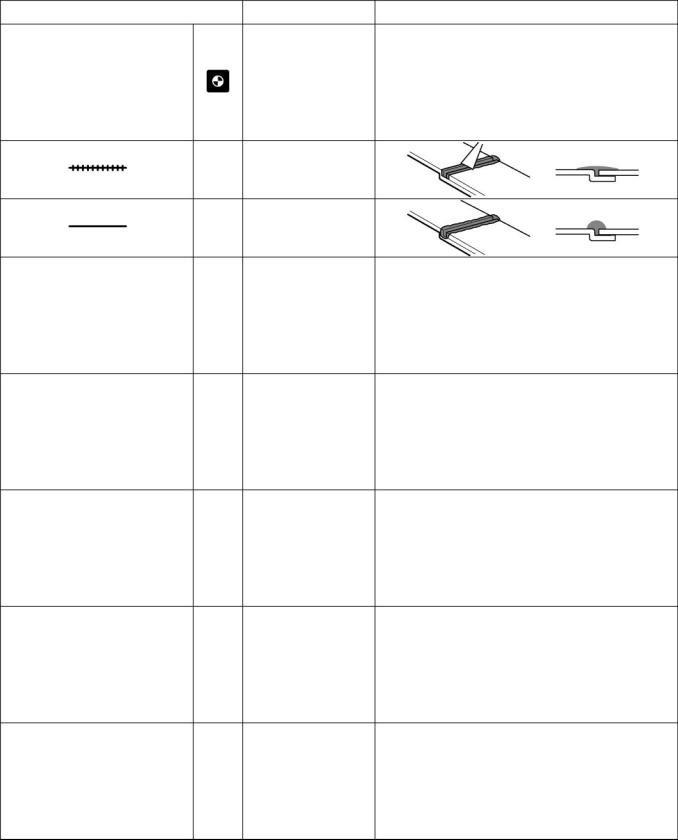
IN-8 |
INTRODUCTION |
SYMBOLS |
MEANING |
ILLUSTRATION |
Ð |
Assembly Mark |
Ð |
Ð |
BODY SEALER |
|
(Flat Finishing) |
||
|
||
Ð |
BODY SEALER |
|
(No Flat Finishing) |
||
|
F13894A
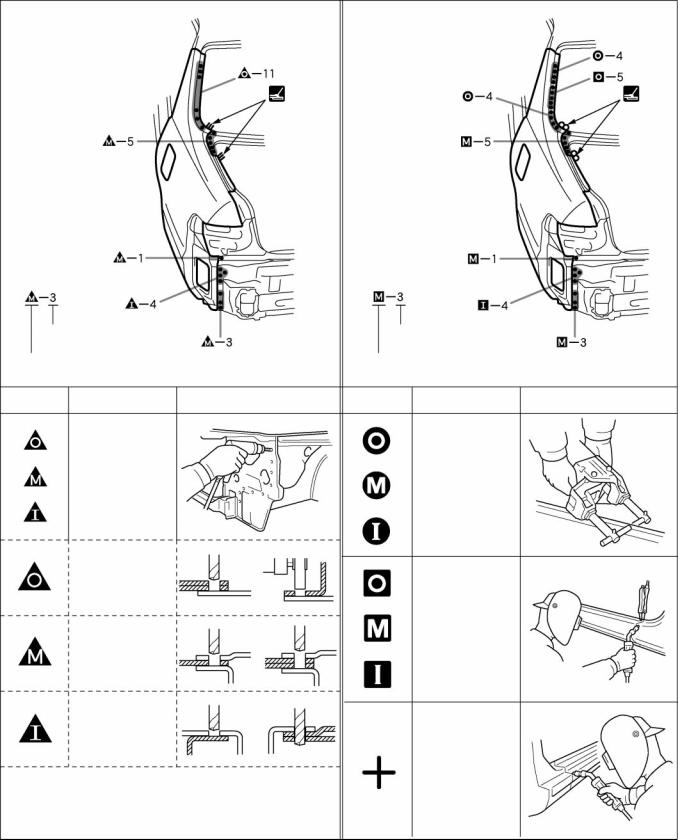
INTRODUCTION |
IN-9 |
3. ILLUSTRATION OF WELD POINT SYMBOLS EXAMPLE:
REMOVAL
Weld points
Remove weld point and panel position
SYMBOLS MEANING |
ILLUSTRATION |
Remove
Weld
Points
(Outside)
(Middle)
(Inside)
HINT: Panel position symbols are as seen from the working posture.
INSTALLATION
Weld points
Weld method and panel position
SYMBOLS MEANING |
ILLUSTRATION |
Spot Weld
MIG Plug
Weld
Spot MIG
Weld
F13892A
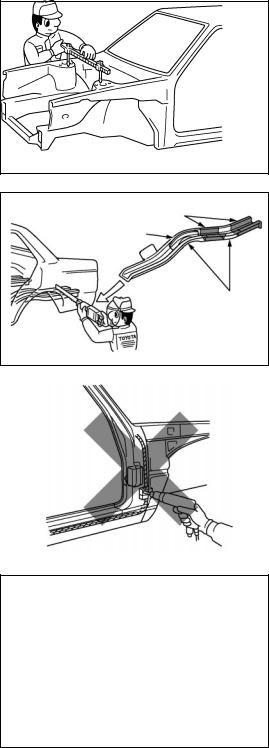
IN-10 |
INTRODUCTION |
PROPER AND EFFICIENT WORK
PROCEDURES
1.REMOVAL
(a)PRE-REMOVAL MEASURING
(1)Before removal or cutting operations, take measurements in accordance with the dimensions diagram. Always use a puller to straighten a damaged body or frame.
F10007A
Cutting Okay
Reinforcement
Corners
F10008A
WRONG |
F10009A |
|
|
(b)CUTTING AREA
(1)Always cut in a straight line and avoid reinforced areas.
(c)PRECAUTIONS FOR DRILLING OR CUTTING
(1)Check behind any area to be drilled or cut to ensure that there are no hoses, wires, etc., that may be damaged.
HINT: See ªHandling Precautions on Related Componentsº on page IN-15.
(d)REMOVAL OF ADJACENT COMPONENTS
(1)When removing adjacent components, apply protective tape to the surrounding body and your tools to prevent damage.
HINT: See ªHandling Precautions on Related Componentsº on page IN-15.
F10010A

INTRODUCTION |
IN-11 |
Less than 3 mm
2.PREPARATION FOR INSTALLATION
(a)SPOT WELD POINTS
(1)When welding panels with a combined thickness of over 3 mm (0.12 in.), use a MIG (Metal Inert Gas) welder for plug welding.
HINT: Spot welding does not provide sufficient durability for panels with a combined thickness of over 3 mm (0.12 in.).
F10011A
(b)APPLICATION OF WELD-THROUGH PRIMER (SPOT SEALER)
(1)Remove the paint from the portion of the new parts and body to be welded, and apply weld-through primer.
F10012A
(c)MAKING HOLES FOR PLUG WELDING
(1)For areas where a spot welder cannot be used, use a puncher or drill to make holes for plug welding.
|
|
REFERENCE: |
mm (in.) |
|
|
|
|
|
|
|
|
|
Thickness of welded portion |
Size of plug hole |
|
|
|
|
|
|
|
|
1.0 (0.04) under |
5 (0.20) ù over |
Puncher |
|
|
|
|
|
|
1.0 (0.04) − 1.6 (0.06) |
6.5 (0.26) ù over |
|
|
|
|
|
|
|
F10013A |
1.7 (0.07) − 2.3 (0.09) |
8 (0.31) ù over |
|
|
|
|
||
|
2.4 (0.09) over |
10 (0.39) ù over |
||
|
|
|
||
|
|
|||
|
|
|
|
|
F10014A
|
20 − 30 mm |
Air Saw |
Overlap |
F10015A
(d)SAFETY PRECAUTIONS FOR ELECTRICAL COMPONENTS
(1)When welding, there is a danger that electrical components will be damaged by the electrical current flowing through the body.
(2)Before starting work, disconnect the negative terminal of the battery and ground the welder near the welding location of the body.
(e)ROUGH CUTTING OF JOINTS
(1)For joint areas, rough cut the new parts, leaving 20 − 30 mm (0.79 − 1.18 in.) of overlap.

IN-12 |
INTRODUCTION |
Body Measurement Diagrams
F10016A
3.INSTALLATION
(a)PRE-WELDING MEASUREMENTS
(1)Always take measurements before installing underbody or engine components to ensure correct assembly. After installation, confirm proper fit.
(b)WELDING PRECAUTIONS
(1)The number of welding spots should be as follows.
Spot weld: 1.3 X No. of manufacturer's spots. Plug weld: More than No. of manufacturer's plugs.
(2)Plug welding should be done with a MIG (Metal Inert Gas) welder. Do not gas weld or braze panels at areas other than specified.
WRONG |
F10017A |
|
(c)POST-WELDING REFINISHING
(1)Always check the welded spots to ensure they are secure.
(2)When smoothing out the weld spots with a disc grinder, be careful not to grind off too much as this will weaken the weld.
CORRECT WRONG
F10018A
New Spot
Old Locations
Spot
Locations
(d)SPOT WELD LOCATIONS
(1)Avoid welding over previously welded areas.
F10020A
|
|
(e) SPOT WELDING PRECAUTIONS |
|
|
|
(1) |
The shape of the tip point of the spot welder signifi- |
|
|
|
cantly affects the strength of the weld. Therefore, |
|
|
|
maintain the tip point in the proper shape, and allow it |
|
|
|
to cool after every five or six spots. |
|
|
(2) |
Completely remove the paint from the areas to be spot |
|
|
|
welded, including the seams and the surfaces that |
|
|
|
come in contact with the welding tip. |
Tip Cutter |
|
(3) |
Use a sander to remove any burrs that are created |
F10019A |
|
during spot welding. |
|
|
|
||
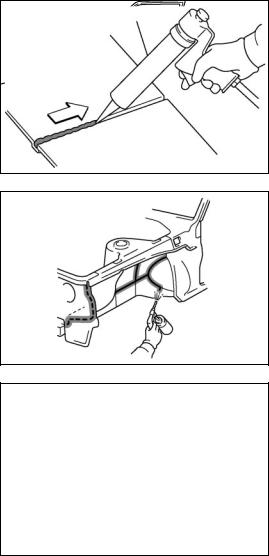
INTRODUCTION |
IN-13 |
Sealer Gun
F10021A
4.ANTI-RUST TREATMENT AFTER INSTALLATION (BEFORE PAINTING PROCESS)
(a)BODY SEALER APPLICATION
(1)For water-proofing and anti-corrosion measures, always apply the body sealer to the body panel seams and hems of the doors, hood, etc.
(b)UNDERCOAT APPLICATION
(1)To prevent corrosion and protect the body from damage by flying stones, always apply sufficient undercoating to the bottom surface of the under body and inside of the wheel housings.
F10022A
5.ANTI-RUST TREATMENT AFTER INSTALLATION (AFTER PAINTING PROCESS)
(a)ANTI-RUST AGENT (WAX) APPLICATION
(1)To preserve impossible to paint areas from corrosion, always apply sufficient anti-rust agent (wax) to the inside of the hemming areas of the doors and hood, and around the hinges, or the welded surfaces inside the box-shapedcross sections of the side members, body pillar, etc.
F10023A

IN-14 |
INTRODUCTION |
6.ANTI-RUST TREATMENT BY PAINTING
REFERENCE:
Painting prevents corrosion and protects the sheet metal from damage. In this section, anti-chipping paint only for anti-corrosion purpose is described.
(a)ANTI-CHIPPING PAINT
(1)To prevent corrosion and protect the body from damage by flying stones, etc., apply anti-chipping paint to the rocker panel, wheel arch areas, balance panel, etc.
HINT:
Depending on the model or the application area, there are cases where the application of anti-chipping paint is necessary before the second coat or after the top coat.
Apply the anti-chipping paint after |
|
Apply the anti-chipping paint before |
the top coat. |
|
the second coat. |
|
Anti-Chipping Paint |
Top Coat |
|
Second Coat |
|
|
|
|
|
Top Coat |
Anti-Chipping Paint |
|
Second Coat |
|
|
|
|
|
Under Coat (ED Primer) |
Under Coat (ED Primer) |
|
Steel Metal |
Steel Metal |
|
|
F10024A |
|
|
|
INTRODUCTION |
IN-15 |
HANDLING PRECAUTIONS ON RELATED COMPONENTS
1.BRAKE SYSTEM
The brake system is one of the most important safety components. Always follow the directions and notes given in the brake (32) section of the repair manual for the relevant model when handling brake system parts.
NOTICE: When repairing the brake master cylinder or TRAC system, bleed the air out of the TRAC system.
2.DRIVE TRAIN AND CHASSIS
The drive train and chassis are components that can have great effects on the running performance and vibration resistance of the vehicle. After installing components in the sections listed in the table below, perform alignments to ensure correct mounting angles and dimensions. Body repair must be particularly accurate to ensure correct alignment.
HINT: Correct procedures and special tools are required for alignment. Always follow the directions given in the repair manual for the relevant model during alignment and section DI of this section.
Component to be aligned |
Section of repair manual |
|
for relevant model |
||
|
||
|
|
|
Front Wheels |
Front Suspension (26) section |
|
|
|
|
Rear Wheels |
Rear Suspension (27) section |
|
|
|
3.COMPONENTS ADJACENT TO THE BODY PANELS
Various types of component parts are mounted directly on or adjacently to the body panels. Strictly observe the following precautions to prevent damaging these components and the body panels during handling.
Before repairing the body panels, remove their components or apply protective covers over the components.
Before prying components off using a screwdriver or a scraper, etc., attach protective tape to the tool tip or blade to prevent damaging the components and the body paint.
Before removing components from the outer surface of the body, attach protective tape to the body to ensure no damage to painted areas.
HINT: Apply touch-up paint to any damaged paint surfaces.
Before drilling or cutting sections, make sure that there are no wires, etc. on the reverse side.
4.ECU (ELECTRONIC CONTROL UNIT)
Many ECUs are mounted in this vehicle.
Take the following precautions during body repair to prevent damage to the ECUs.
Before starting electric welding operations, disconnect the negative (−) terminal cable from the battery.
When the negative (−) terminal cable is disconnected from the battery, memory of the clock and audio systems will be canceled. So before starting work, make a record of the contents memorized by each memory system. Then when work is finished, reset the clock and audio systems as before.
When the vehicle has tilt and telescopic steering, power seats and outside rear view mirrors, which are all equipped with a memory function, it is not possible to make a record of the memory contents. So when the operation is finished, it will be necessary to explain this fact to the customer, and request the customer to adjust the features and reset the memory.
Do not expose the ECUs to ambient temperatures above 80 C (176 F).
NOTICE: If it is possible the ambient temperature may reach 80 C (176 F) or more, remove the ECUs from the vehicle before starting work.
Be careful not to drop the ECUs and not to apply physical shocks to them.

IN-16
INTRODUCTION
PRECAUTIONS FOR REPAIRING BODY STRUCTURE PANELS
1.HEAT REPAIR FOR BODY STRUCTURE PANELS
Toyota prohibits the use of the heat repair method on body structure panels when repairing a vehicle damaged in a collision.
Panels that have high strength and rigidity, as well as a long life span for the automobile body are in high demand.
At Toyota, in order to fulfill these requirement, we use high tensile strength steel sheets and rust preventive steel sheets on the body. High tensile steel sheets are made with alloy additives and a special heat treatment in order to improve the strength.
To prevent the occurrence of rust for a long period of time, the surface of the steel is coated with a zinc alloy.
If body structure parts are heat repaired with an acetylene torch or other heating source, the crystalline organization of the steel sheet will change and the strength of the steel sheet will be reduced. The ability of the body to resist rust is significantly lowered as well since the rust resistant zinc coating is destroyed by heat and the steel sheet surface is oxidized.
2.STRUCTURE PANEL KINKS
A sharp deformation angle on a panel that cannot be returned to its original shape by pulling or hammering is called a kink.
Structural parts are designed to perform in their original shape. If parts are deformed in an accident, or if the deformed parts are repaired and reused, the parts may be unable to perform as intended.
It is necessary to replace the part where the kink has occurred.
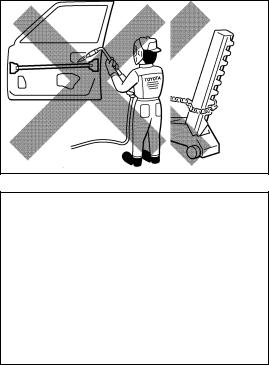
INTRODUCTION |
IN-17 |
3.IMPACT BEAM REPAIR
The impact beam and bracket are necessary and important parts that help reduce the probability of injury to passengers in side collisions.
For impact beams, we use special high tensile strength steel.
The high tensile strength steel maintains its special crystalline organization by heat treatment or alloy additives. Structural parts are designed to perform in their original shape. If parts are deformed in an accident, or if the deformed parts are repaired and reused, the parts may be unable to perform as intended.
If the impact beam or bracket is damaged, replace the door assembly with the damaged beam.
Also, the bumper reinforcement is a necessary and important part that helps reduce the probability of injury to passengers in front collisions, and for the same reasons explained above, should be replaced if damaged.
IN-18 |
INTRODUCTION |
ABBREVIATIONS USED IN THIS MANUAL
For convenience, the following abbreviations are used in this manual.
ABS A/C assy ECT ECU e.g. Ex.
FWD 2WD 4WD in.
LH
LHD MIG M/Y PPS RH RHD SRS SSM w/ w/o
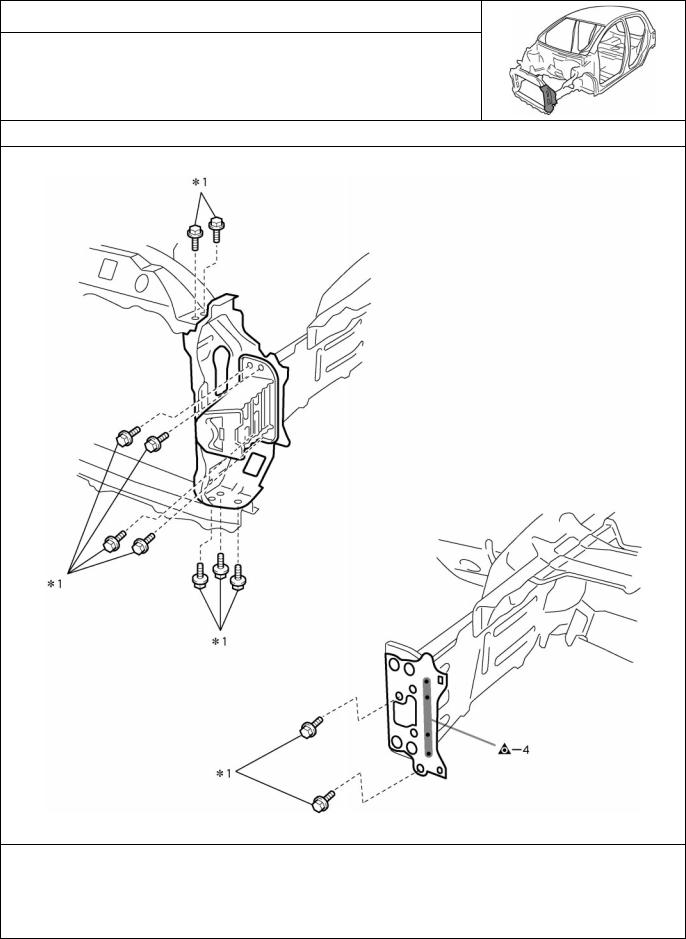
BODY PANEL REPLACEMENT |
BP-1 |
RADIATOR SUPPORT (ASSY)
REPLACEMENT
F22816A
REMOVAL
F22816
POINT
1 *1: Bolt
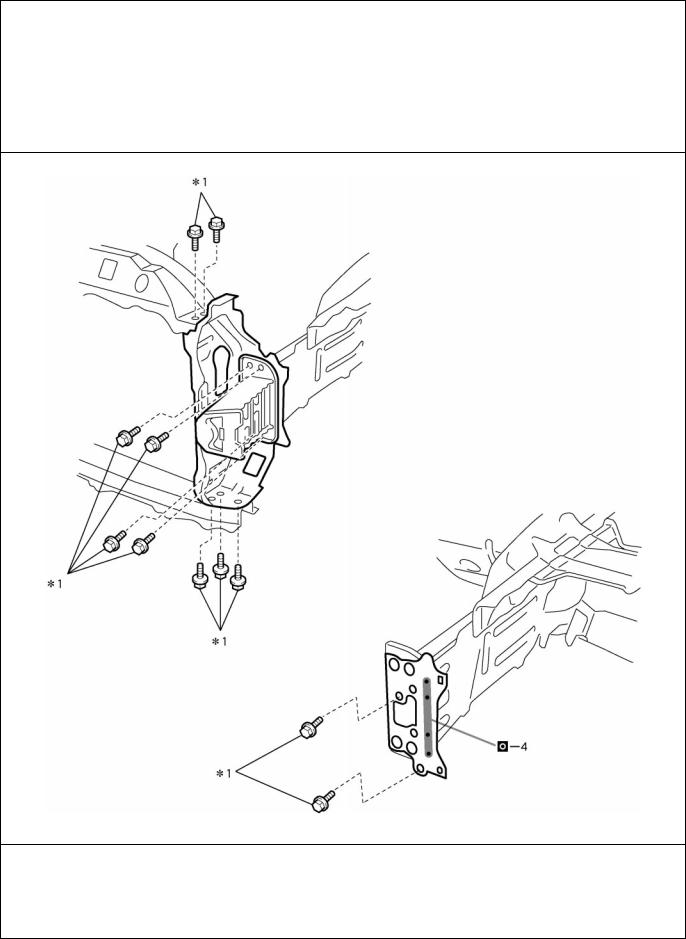
BP-2 |
BODY PANEL REPLACEMENT |
INSTALLATION
Temporarily install the new parts and measure each part of the new parts in accordance with the body dimension diagram. (See the body dimension diagram)
Inspect the fitting of the related parts around the new parts before welding. This affects the appearance of the finish.
After welding, apply polyurethane foam to the corresponding parts.
After welding, apply body sealer and undercoating to the corresponding parts.
After applying the top coat, apply anti-rust agent to the internal panel portion of the closed section structural weld points.
F22817
POINT
1Inspect the fitting of the headlight, front fender, hood and other related parts, before welding as this affects the appearance of the finish.
2*1: Bolt
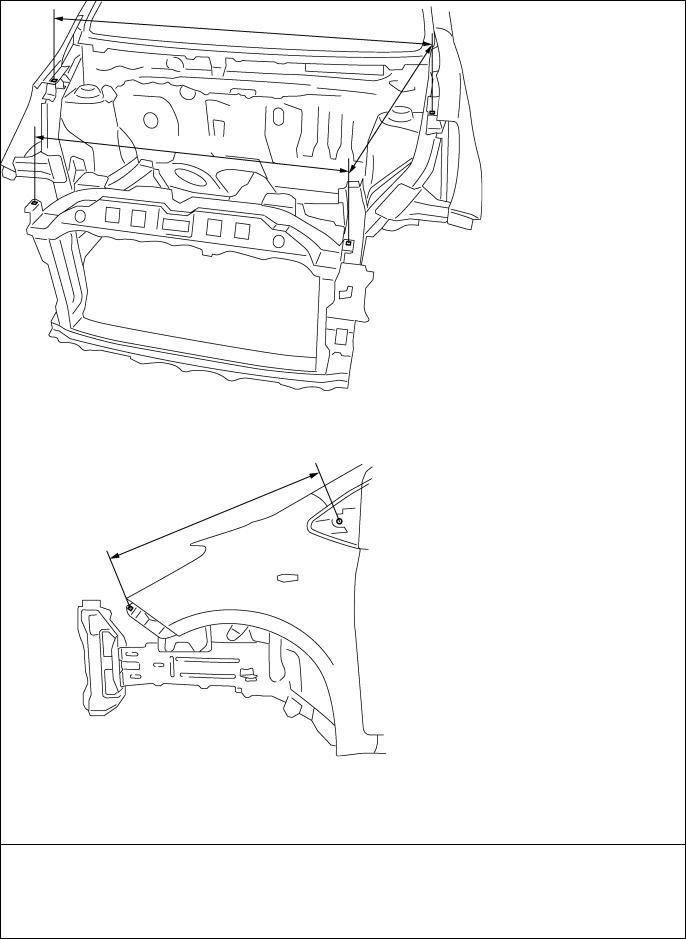
BODY PANEL REPLACEMENT |
BP-3 |
1,324 mm
530 mm
944 mm
742 mm
F22818
POINT
1Measure the dimensions before installing the headlight.
2These values are reference values.
530 mm (20.87 in.) |
742 mm (29.21 in.) |
944 mm (37.17 in.) |
1,324 mm (52.13 in.) |
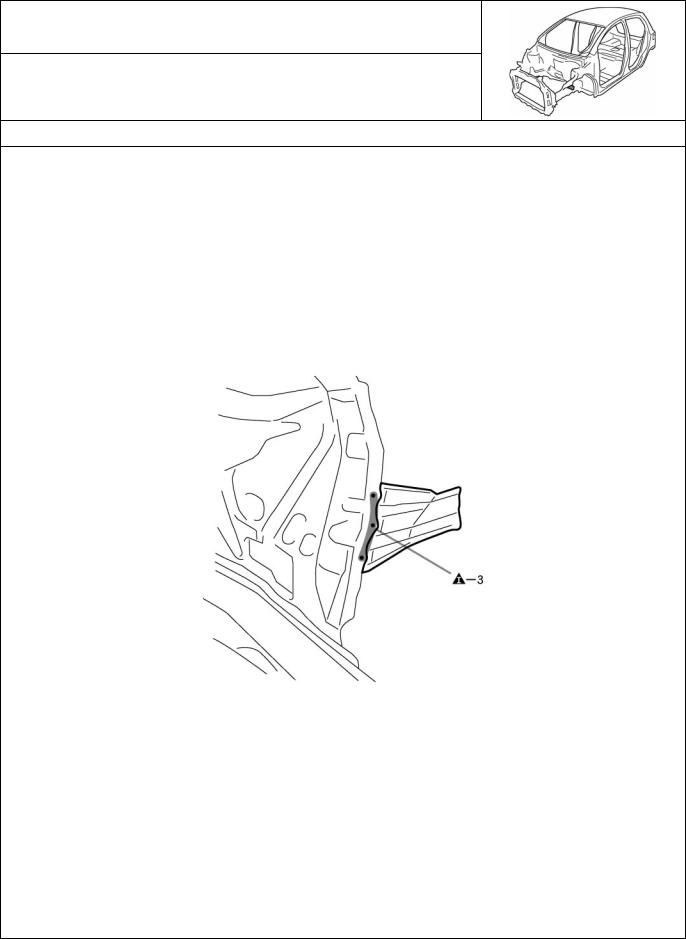
BP-4 |
BODY PANEL REPLACEMENT |
FRONT FENDER MOUNTING BRACKET (ASSY)
REPLACEMENT
F22819A
REMOVAL
F22819
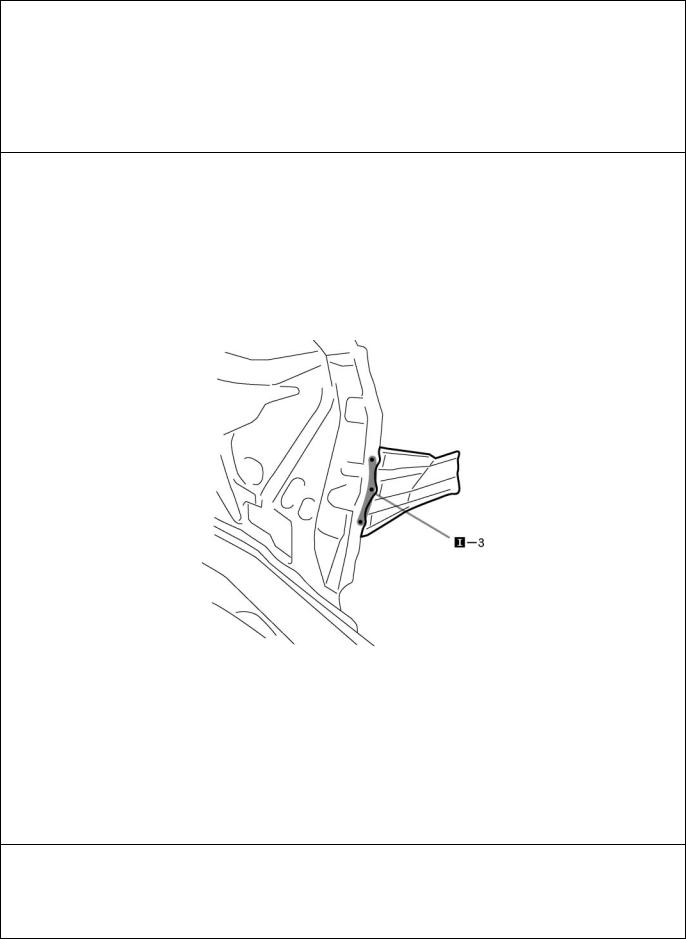
BODY PANEL REPLACEMENT |
BP-5 |
INSTALLATION
Temporarily install the new parts and measure each part of the new parts in accordance with the body dimension diagram. (See the body dimension diagram)
Inspect the fitting of the related parts around the new parts before welding. This affects the appearance of the finish.
After welding, apply polyurethane foam to the corresponding parts.
After welding, apply body sealer and undercoating to the corresponding parts.
After applying the top coat, apply anti-rust agent to the internal panel portion of the closed section structural weld points.
F22820
POINT
1Inspect the fitting of the front fender and other related parts before welding as this affects the appearance of the finish.
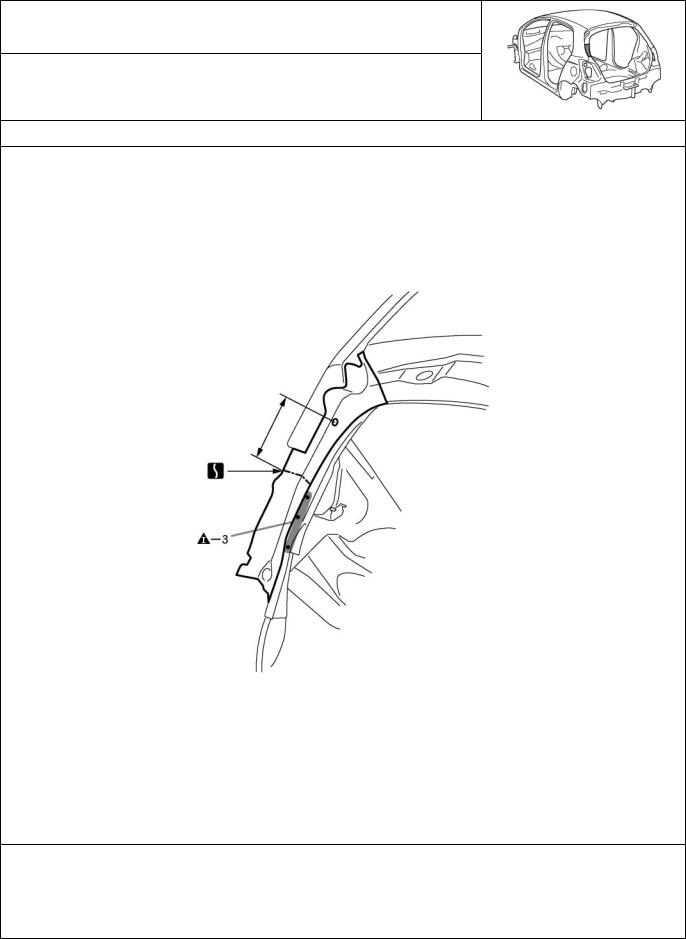
BP-110 |
BODY PANEL REPLACEMENT |
QUARTER PANEL UPPER EXTENSION
(CUT): Hatchback
REPLACEMENT
With the back door opening trough removed.
F22867A
REMOVAL
130 mm
F22867
130 mm (5.12 in.)
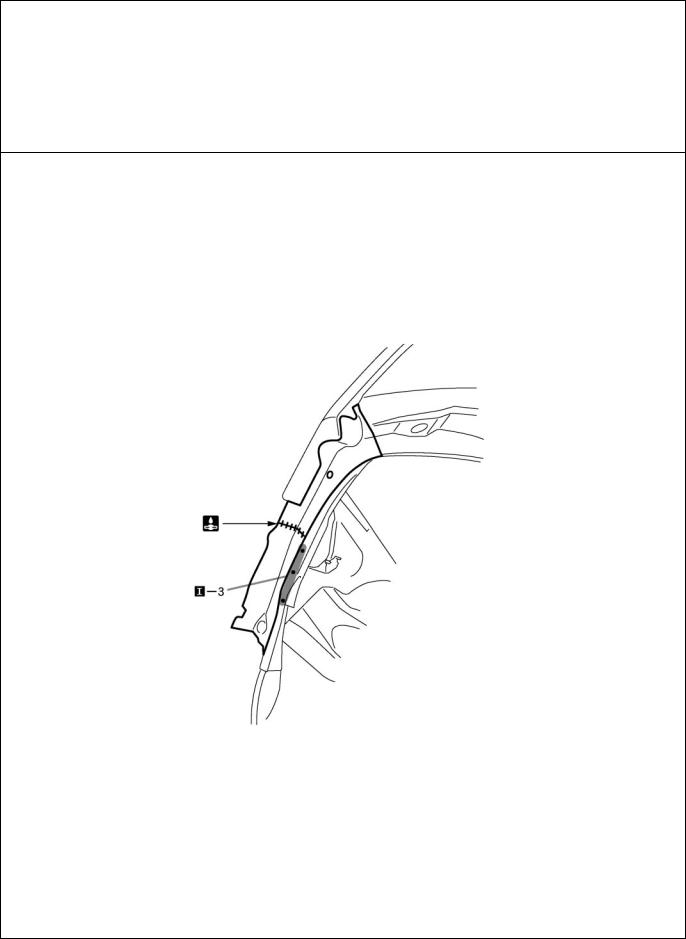
BODY PANEL REPLACEMENT |
BP-111 |
INSTALLATION
Temporarily install the new parts and measure each part of the new parts in accordance with the body dimension diagram. (See the body dimension diagram)
Inspect the fitting of the related parts around the new parts before welding. This affects the appearance of the finish.
After welding, apply the polyurethane foam to the corresponding parts.
After welding, apply body sealer and under-coating to the corresponding parts.
After applying the top coat layer, apply anti-rust agent to the inside of the necked section structural weld spots.
F22868
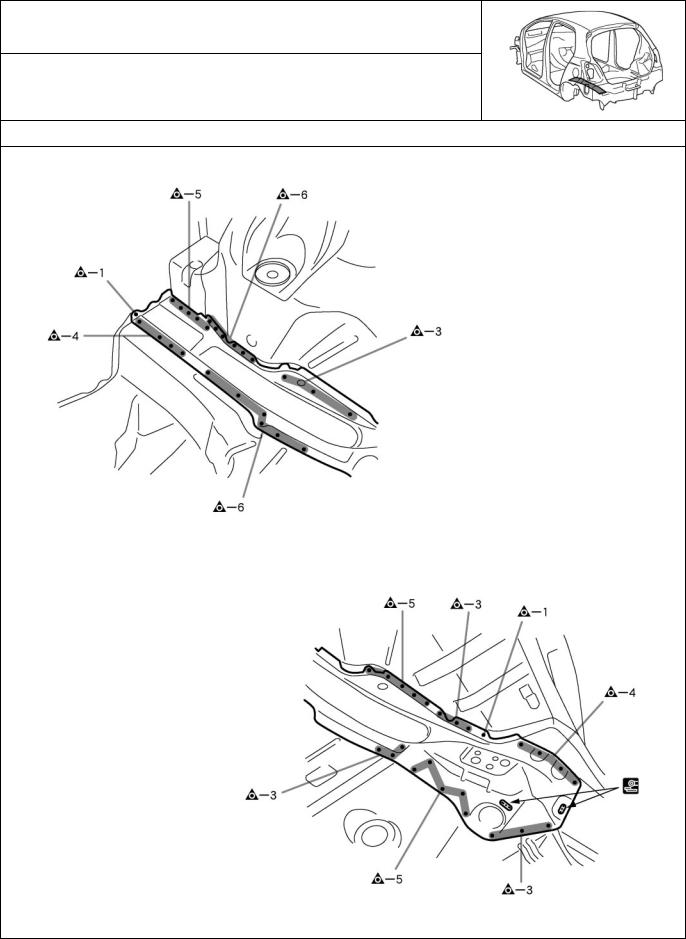
BP-112 |
BODY PANEL REPLACEMENT |
FLOOR SIDE RAIL FRONT PANEL (ASSY):
Hatchback
REPLACEMENT
With the body lower back panel removed.
F22869A
REMOVAL
F23327

BODY PANEL REPLACEMENT |
BP-113 |
INSTALLATION
Temporarily install the new parts and measure each part of the new parts in accordance with the body dimension diagram. (See the body dimension diagram)
Inspect the fitting of the related parts around the new parts before welding. This affects the appearance of the finish.
After welding, apply the polyurethane foam to the corresponding parts.
After welding, apply body sealer and under-coating to the corresponding parts.
After applying the top coat layer, apply anti-rust agent to the inside of the necked section structural weld spots.
(10 mm 2)
F23328
10 mm ( 0.39 in.)
